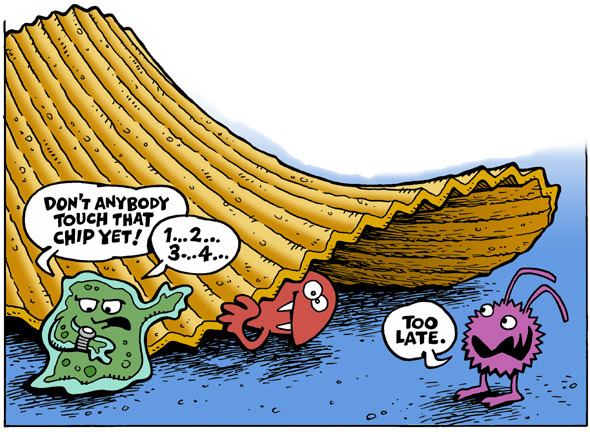 | ||
The five-second rule is a western food hygiene concept, that states that there is a five second window to pick up food (or sometimes cutlery) after it has been dropped and thus exposed to contamination. Some may truly believe this assertion, whereas most people employ the rule as an amusing social fiction that allows them to eat a dropped piece of food, despite the potential reservations of their peers. The "rule" has been scientifically proven false.
Contents
The time of origin of the myth is unclear. Some refer to it as the three-second rule.
Research
The five-second rule has received some scholarly attention. It has been studied as both, a public health recommendation and a sociological effect.
In 2003, Jillian Clarke of the University of Illinois at Urbana–Champaign found in a survey that 56% of men and 70% of women surveyed, were familiar with the five-second rule. She also determined that a variety of foods were significantly contaminated by even brief exposure to a tile inoculated with E. coli. On the other hand, Clarke found no significant evidence of contamination on public flooring. For this work, Clarke received the 2004 Ig Nobel Prize in public health. A more thorough study in 2006 using salmonella on wood, tiles, and nylon carpet, found that the bacteria were able to thrive under dry conditions even after twenty-eight days. Tested after eight hours of exposure, the bacteria was still able to contaminate bread and bologna in under five seconds. But a minute-long contact increased contamination about tenfold (especially tile and carpet surfaces). The researchers at the Rutgers University also debunked this theory by dropping watermelon cubes, Haribo strawberry gummies, plain white bread, and buttered bread from a height of five inches on to the ground. The surfaces selected were slathered in Enterobacter aerogenes. The surfaces used were carpet, ceramic tile, stainless steel and wood. The food was left on the surface in intervals of 5, 30 and 300 seconds. The scientists assessed the amount of E.aerogens transferred between surface and food. Since Bacteria tended to be attracted to moisture, wet food had more risk to have bacteria transferred then dry food. To the surprise of the researchers, carpet transferred fewer bacteria than steel or tile. Wood was hard to pin down. It showed a large variation. The scientists concluded that five-second rule is a “significant oversimplification” for the chance of bacteria to be transferred in real life.
In a 2014 study, by biology students at Aston University in England, suggested that there may be a basis for the five-second rule.
The five-second rule was also featured in an episode of the Discovery Channel series MythBusters. There was no significant difference in the number of bacteria collected.The aspects that affect the contamination process is the moisture, surface geometry and the location. Ted Allen put the rule to the test in an episode of Food Detectives, and found that bacteria will cling to food immediately. Vsauce, a YouTube channel, also dedicated a video to this topic.
In a review article, a pediatrician discounted the danger in consuming certain foods dropped on to floors.
The New York Times has an article on five second rule that states “You may think your floors are so clean you can eat off them, but a new study debunking the so-called five-second rule would suggest otherwise.”
“The five-second rule is a significant oversimplification of what actually happens when bacteria transfer from a surface to food,” Donald Schaffner, a Rutgers University biologist and an author of the research, said in a statement. “Bacteria can contaminate instantaneously.” A statement from the Washington Post. There was a study by Jilian Clark during a six week internship in the food science and nutrition department at the University of Illinois.
Polls
Babycenter.com has done a poll on the five second rule, and as of right now; 58% of parents say they follow the five second rule at home, 20% say they use the rule all the time, and 22% say they don’t use the rule at all. https://www.babycenter.com/4_do-you-follow-the-five-second-rule_1746292.bc
Total News Wire has also done a poll on the five second rule, and as of right now 58.97% have said “heck yes” and 41.03 have said “heck no”. http://totalnewswire.com/do-you-believe-in-the-five-second-rule-poll/
